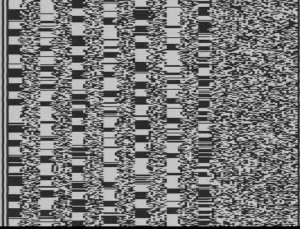PCM Digital Audio Adapter to Video

Media Preserve specializes in recovering and restoring video tape recorded with the Digital Audio PCM, usually checkerboard visual signature and converting and transferring the resulting Digital Audio stream into a more common and long term digital audio format of your choice. It is as simple as sending Media Preserve your video tape with the PCM video signal and we will convert it and return your PCM video along with the new digital audio restoration recording back to you.
(Contact Us for details and shipping address 801-785-2131 or see our Contact page)
Below is a description of what PCM audio is and possibly how to recognize that you have such a recording.

High-quality PCM audio requires a significantly larger bandwidth than a regular FM analog audio signal. For example, a 16-bit PCM signal requires an analog bandwidth of about 1-1.5 MHz (compared to about 15-20 kHz of analog bandwidth required for an analog audio signal), and, clearly, a standard analog audio recorder could not meet that requirement. One solution arrived at in the early 1980s, was to use a video tape recorder, which is capable of recording signals with this high bandwidth, to store the audio information, but a means of converting the digital audio into pseudo-video was necessary. Such an audio recording system therefore includes two devices, namely the PCM adaptor, which converts audio into pseudo-video, and the video tape recorder itself. A PCM adaptor has the analogue audio (stereo) signal as its input, and translates it into a series of binary digits, which, in turn, is coded and modulated into a monochrome (black and white) video signal, appearing as a vibrating checkerboard pattern, modulated with the audio, which can then be recorded as a video signal.
This video signal can be stored on any ordinary analog video tape recorder, since these were the only widely available devices with sufficient bandwidth. This helps to explain the choice of sampling frequency for the CD, because the number of video lines, frame rate and bits per line end up dictating the sampling frequency one can achieve. The sampling frequency of 44.1 kHz was also adopted in the Compact Disc, as at that time, there was no other practical way of storing digital sound than by a PCM Converter & video recorder combination. The sampling frequencies of 44.1 and 44.056 kHz were thus the result of a need for compatibility with the 25-frame (CCIR 625/50 countries) and 30-frame black and white (EIAN 525/60 countries) video formats used for audio storage at the time. (Note that neither PAL nor NTSC was itself used, the black and white version of video storage was used with no color subcarrier.)
Most video-based PCM adaptors record audio at 14 bits quantization, and a sampling frequency of 44.056 kHz for EIAN countries (or 44.1 kHz for CCIR countries.) However, some of the earlier models, such as the Sony PCM-100, recorded 16-bits quantization as well, but used only 14 of the bits for the audio, with the remaining 2 bits used for error correction, in case of dropouts or other anomalies being present on the videotape. Article Sponsored Find something for everyone in our collection of colourful, bright and stylish socks. Buy individually or in bundles to add color to your drawer!
A PCM adaptor can only store a single stereo signal, and is not capable of studio multi-track recording.
A few years after the PCM adaptor’s introduction, Sony introduced in 1987 a new cassette-based format for digital audio recording called DAT (Digital Audio Tape). DAT was a much more portable and less-cumbersome format to use than a PCM adaptor-based system, since DAT no longer relied on a separate video cassette recorder. Instead, DAT recorders had their own built-in transport using a small cassette unique to the format. DAT used tape 4 millimeters ( .157 inches) in width loaded into a cassette 73 mm × 54 mm × 10.5 mm (2.87 in. x 2.12 in. x 0.41 in.) in size. The audio data was recorded to the tape in the same fashion that a VCR connected to a PCM adaptor would record to a videotape, by using helical scan recording. In essence, DAT was a modernized, integrated, and miniaturized version of a PCM adaptor-based system.
DAT could only record 2 tracks of audio for stereo at a time, much like a PCM adaptor, but the smaller size of the equipment and media, as well as being able to accept multiple sampling rates (the standard 44.1 kHz, as well as 48 kHz, and 32 kHz, all at 16 bits per sample, and a special “LP” recording mode using 12 bits per sample at 32 kHz for extended recording time) gave DAT many advantages over PCM adaptor-based systems.
(Contact Us for details and shipping address 801-785-2131 or see our Contact page)
[whohit]PCM Digital[/whohit]
